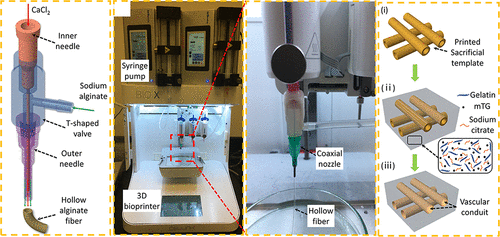当前位置:
X-MOL 学术
›
ACS Biomater. Sci. Eng.
›
论文详情
Our official English website, www.x-mol.net, welcomes your
feedback! (Note: you will need to create a separate account there.)
Rapid Fabrication of Ready-to-Use Gelatin Scaffolds with Prevascular Networks Using Alginate Hollow Fibers as Sacrificial Templates
ACS Biomaterials Science & Engineering ( IF 5.4 ) Pub Date : 2020-02-25 , DOI: 10.1021/acsbiomaterials.9b01834 Shuai Li 1, 2 , Kan Wang 1 , Xuzhou Jiang 1 , Qingxi Hu 2, 3, 4 , Chuck Zhang 1, 5 , Ben Wang 1, 5, 6
ACS Biomaterials Science & Engineering ( IF 5.4 ) Pub Date : 2020-02-25 , DOI: 10.1021/acsbiomaterials.9b01834 Shuai Li 1, 2 , Kan Wang 1 , Xuzhou Jiang 1 , Qingxi Hu 2, 3, 4 , Chuck Zhang 1, 5 , Ben Wang 1, 5, 6
Affiliation

|
In this study, we developed a facile manufacturing method for interconnected prevascular networks using calcium chloride (CaCl2) cross-linked alginate hollow fibers as sacrificial templates. The resulting network can be used to deliver oxygen and nutrients and remove waste for embedded cells in large-volume gelatin scaffolds during in vitro culturing. The sacrificial templates were printed by customized coaxial nozzles and embedded in scaffolds made of a mixture of gelatin, microbial transglutaminase (mTG), and sodium citrate. During the cross-linking of gelatin and mTG, the sacrificial templates started to dissolve from the scaffold–template interface due to the presence of the sodium citrate in the gelatin. The embedded sacrificial templates were completely dissolved without any postprocessing, and the designed prevascular networks successfully retained their geometries and dimensions. No residue of the template was observed at the scaffold–template interface after dissolution, which promoted cell adhesion. This manufacturing method has a high degree of freedom in templates’ geometry, which was demonstrated by fabricating prevascular networks with various designs, including grid, branched, and dendritic networks. The effects of hollow fiber size and sodium citrate concentration on the dissolution time were analyzed. Human umbilical vein endothelial cells were injected into the aforementioned networks and formed a confluent endothelial cell monolayer with high viability during the culture process. The results suggest great promise to rapidly build large-scale ready-to-use gelatin scaffolds with prevascular networks for the applications in tissue engineering.
中文翻译:

使用藻酸盐空心纤维作为牺牲模板,通过血管前网络快速制备现成的明胶支架。
在这项研究中,我们开发了一种简便的制造方法,该方法使用氯化钙(CaCl 2)交联的藻酸盐中空纤维作为牺牲模板来互连血管前网络。由此产生的网络可用于输送氧气和营养,并在体外去除大体积明胶支架中嵌入式细胞的废物培养。牺牲模板通过定制的同轴喷嘴打印,并嵌入由明胶,微生物转谷氨酰胺酶(mTG)和柠檬酸钠的混合物制成的支架中。在明胶和mTG的交联过程中,由于明胶中存在柠檬酸钠,因此牺牲模板开始从支架-模板界面溶解。嵌入的牺牲模板完全溶解,无需任何后处理,并且设计的血管前网络成功保留了它们的几何形状和尺寸。溶解后,在支架-模板界面上未观察到模板的残基,从而促进了细胞粘附。这种制造方法在模板的几何形状上具有高度的自由度,这一点已通过制作具有各种设计的血管前网络(包括网格,分支和树突状网络。分析了中空纤维尺寸和柠檬酸钠浓度对溶解时间的影响。将人脐静脉内皮细胞注射到上述网络中,并在培养过程中形成具有高存活力的融合内皮细胞单层。结果表明,有望快速构建具有血管前网络的大规模即用明胶支架,以用于组织工程。
更新日期:2020-02-25
中文翻译:

使用藻酸盐空心纤维作为牺牲模板,通过血管前网络快速制备现成的明胶支架。
在这项研究中,我们开发了一种简便的制造方法,该方法使用氯化钙(CaCl 2)交联的藻酸盐中空纤维作为牺牲模板来互连血管前网络。由此产生的网络可用于输送氧气和营养,并在体外去除大体积明胶支架中嵌入式细胞的废物培养。牺牲模板通过定制的同轴喷嘴打印,并嵌入由明胶,微生物转谷氨酰胺酶(mTG)和柠檬酸钠的混合物制成的支架中。在明胶和mTG的交联过程中,由于明胶中存在柠檬酸钠,因此牺牲模板开始从支架-模板界面溶解。嵌入的牺牲模板完全溶解,无需任何后处理,并且设计的血管前网络成功保留了它们的几何形状和尺寸。溶解后,在支架-模板界面上未观察到模板的残基,从而促进了细胞粘附。这种制造方法在模板的几何形状上具有高度的自由度,这一点已通过制作具有各种设计的血管前网络(包括网格,分支和树突状网络。分析了中空纤维尺寸和柠檬酸钠浓度对溶解时间的影响。将人脐静脉内皮细胞注射到上述网络中,并在培养过程中形成具有高存活力的融合内皮细胞单层。结果表明,有望快速构建具有血管前网络的大规模即用明胶支架,以用于组织工程。











































 京公网安备 11010802027423号
京公网安备 11010802027423号